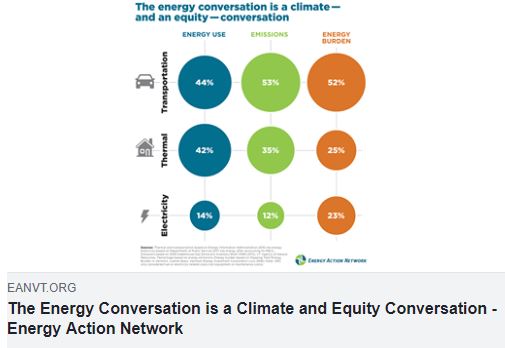Energy Action Network (EAN), a High Meadows Fund grantee, released its Annual Progress Report for Vermont earlier this month. There are three big takeaways:
- Vermont is far off the pace necessary to meet our renewable energy and emissions reduction commitments.
- Vermonters have a lot to gain in terms of energy affordability, local jobs, and renewed economic vitality once we get serious about meeting these commitments.
- The costs of transportation and heating hit Vermonters hard, especially Vermonters with low income.
While Vermont has made significant progress in making our electric sector more renewable, electricity is only responsible for 14% of our energy use and 10% of our total greenhouse gas emissions. Transportation and heating make up the vast majority of Vermont’s energy use (86%) and our emissions (71%). Previously, we’ve written about policies to help clean up these two sectors.
Most Vermonters already know about the sobering scientific reality and have a sense of our profound moral responsibility to confront the climate challenge. But what’s less well known, and what the EAN report shines a hopeful spotlight on, is the considerable economic opportunity for Vermont in meeting its energy and climate commitments.
The economic benefits come at two levels:
- Lower energy costs for Vermonters. Let’s take the example of heating. Over half of Vermonters heat their homes with fuel oil or propane. These are the two most expensive heating fuels—with the most volatile prices—and they put a major strain on family budgets. By contrast, investing in weatherization and switching to sustainable wood heating (either with automated boilers or furnaces or efficient stoves) and/or efficient heat pumps offer Vermonters far lower fuel costs and real savings over time.
- A stronger, more resilient Vermont economy. Not only is our fossil fuel dependence expensive for Vermonters when compared to efficient and renewable alternatives, fossil fuels are also a massive drain on the Vermont economy. Vermont imports 100% of the fossil fuels we use, and anywhere from 70 to 80 cents of every dollar that we spend on those fuels leave the state. That amounts to 1.5 to 2 billion dollars leaving the Vermont economy every year.

Weatherization, advanced wood heat, and heat pumps keep three to four times more of our energy dollars local when compared to fossil fuels. These dollars recirculate and grow our economy by supporting local businesses and new job creation here in Vermont.
There are already nearly 19,000 clean energy jobs in Vermont. These jobs pay better than average, with a median wage of $27 an hour versus $19 an hour for Vermont overall. The more we can move off fossil fuels and toward efficient and renewable energy use, the better off our economy will be.
EAN’s report makes clear that until we make significant investments in the transition to more efficient and renewable ways of heating our homes and getting around, we will have almost no chance of meeting our state commitments. We’ll also be missing out on one of the great economic opportunities of our time.
The release of EAN’s report is just the beginning of this important conversation across Vermont. On Tuesday, April 9th EAN is partnering with VTDigger to co-host a public discussion in White River Junction about the future of transportation—the largest source of energy use, emissions, and energy costs—in Vermont. The event will begin with a presentation from EAN Executive Director Jared Duval, followed by a conversation moderated by VT Digger reporter Mark Johnson including Senate President Tim Ashe, Deputy Secretary of the Agency of Natural Resources, Peter Walke, and Representative Sarah Copeland-Hanzas.
You can RSVP for the event here: https://www.eventbrite.com/e/the-road-to-the-future-transportation-in-vermont-tickets-59245263177